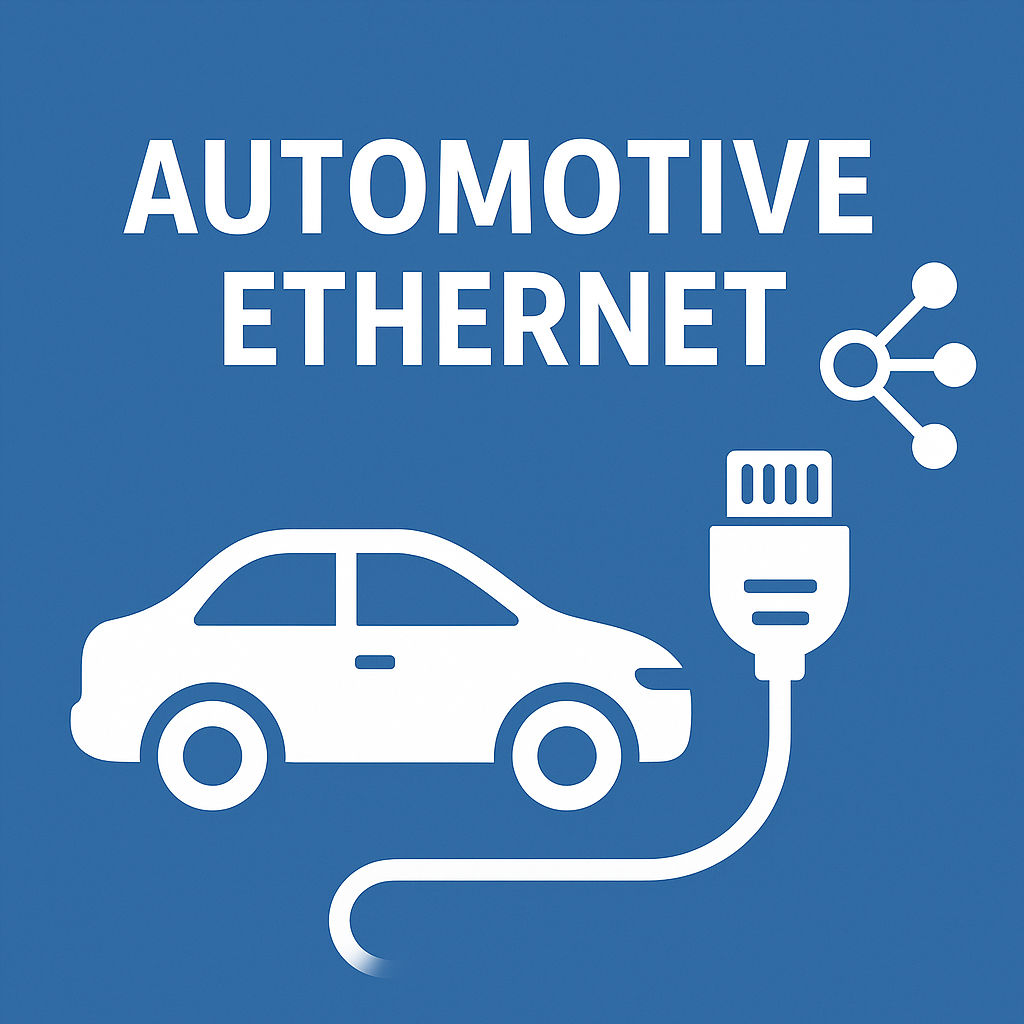Unlock the future of connected vehicles with our Master Beginner-Friendly Guide to Automotive Ethernet (2025). This comprehensive article breaks down complex automotive networking concepts into easy-to-understand language, perfect for beginners eager to learn about the technology transforming in-vehicle communication. Discover how Automotive Ethernet enhances data speed, reliability, and scalability in modern cars, supports advanced driver-assistance systems (ADAS), and enables seamless integration of infotainment and autonomous driving features. Stay ahead in the automotive industry by mastering the fundamentals, benefits, key standards, and real-world applications of Automotive Ethernet. Whether you’re a student, engineer, or tech enthusiast, this guide equips you with everything you need to understand and embrace the future of in-vehicle networking.
What is Automotive Ethernet?
Automotive Ethernet is a technology that uses standard Ethernet communication (the same technology used in computer networks) to connect different electronic systems inside a vehicle. Think of it as the digital highway inside your car, enabling faster, more reliable data exchange between systems like cameras, sensors, infotainment, and advanced driver assistance systems (ADAS).
Why Do We Need Automotive Ethernet?
Modern vehicles are becoming “computers on wheels.” With features like:
- Advanced Driver Assistance Systems (ADAS)
- High-resolution cameras
- Radar and LiDAR sensors
- Infotainment systems with streaming media
- Over-the-air software updates
All these systems generate and exchange massive amounts of data. Traditional automotive networks like CAN, LIN, or FlexRay simply can’t handle the high speeds and bandwidth requirements. That’s where Automotive Ethernet comes in.
Benefits of Automotive Ethernet
Here’s why Automotive Ethernet is gaining popularity:
✅ High Bandwidth: Supports speeds from 100 Mbps up to 10 Gbps, ideal for high-resolution video and fast data communication.
✅ Scalability: Easy to upgrade as vehicles evolve with new technologies.
✅ Cost-Effective: Uses lightweight, affordable cables compared to traditional automotive cabling.
✅ Reduced Weight: Single-pair Ethernet cables are lighter than traditional multi-wire harnesses, improving fuel efficiency.
✅ Interoperability: Leverages global Ethernet standards, allowing easier integration with existing IT infrastructure.
Automotive Ethernet vs. Traditional Networks
| Feature | Automotive Ethernet | CAN / LIN / FlexRay |
|---|---|---|
| Speed | Up to 10 Gbps | Typically < 1 Mbps |
| Cabling | Twisted pair | Heavier multi-wire |
| Video/Data Support | Excellent | Limited |
| Cost | Becoming cost-effective | Historically cheaper |
| Weight | Lower | Higher |
While CAN and LIN remain crucial for simple, low-speed tasks (like window controls or simple sensors), Ethernet is essential for data-intensive systems.
What is 100BASE-T1 and 1000BASE-T1?
You might hear terms like 100BASE-T1 or 1000BASE-T1. These refer to specific Automotive Ethernet standards:
- 100BASE-T1: 100 Mbps over a single twisted pair cable
- 1000BASE-T1: 1 Gbps (Gigabit Ethernet) over a single twisted pair
Both are designed for automotive environments, providing robust communication even in noisy conditions.
Where is Automotive Ethernet Used in Cars?
Automotive Ethernet is already being used in:
- Surround-view cameras
- Radar/LiDAR sensors
- Infotainment systems
- Digital instrument clusters
- Advanced driver assistance systems (ADAS)
- Vehicle diagnostics and over-the-air updates
Is Automotive Ethernet Safe?
Yes! Automotive Ethernet is designed with strict standards like Time-Sensitive Networking (TSN) to ensure data reaches its destination reliably and on time—critical for safety-related applications.
The Future of Automotive Ethernet
Industry experts predict rapid growth of Ethernet in vehicles. As cars move toward higher levels of autonomy (self-driving), data demands will explode, making Automotive Ethernet essential for:
- Autonomous driving systems
- Real-time video streaming
- Vehicle-to-everything (V2X) communication
- Advanced cybersecurity frameworks
Final Thoughts
Automotive Ethernet is transforming how vehicles communicate internally, bringing high-speed, reliable, and cost-effective networking to modern and future vehicles. For anyone passionate about automotive technology, understanding Automotive Ethernet is a valuable step toward the future of smart, connected cars.
FAQs About Automotive Ethernet
Q: Is Automotive Ethernet the same as regular Ethernet?
No. While they share the same principles, Automotive Ethernet is designed to handle high temperatures, vibrations, and electromagnetic noise typical in vehicles.
Q: Will Ethernet replace all automotive networks?
Not entirely. Low-speed networks like CAN or LIN are still cost-effective for simple tasks. Ethernet will coexist, mainly handling high-data applications.
Q: Is Automotive Ethernet expensive?
Costs have dropped significantly. As volumes increase, Automotive Ethernet becomes more affordable and competitive with traditional networks.
Excellent — let’s add external links to reliable resources so readers can learn more about Automotive Ethernet. Here’s a list of trusted references you can safely include in your article or blog post:
Top Reliable Resources and External Links to Learn More About Automotive Ethernet
✅ Open Alliance (Industry Group for Automotive Ethernet Standards)
https://www.opensig.org
This is the key industry consortium defining Automotive Ethernet specifications like 100BASE-T1 and 1000BASE-T1.
✅ IEEE 802.3 Working Group (Ethernet Standards)
https://www.ieee802.org/3/
IEEE defines the core Ethernet standards, including those adapted for automotive use.
✅ Ethernet Alliance (Educational Resources)
https://ethernetalliance.org/
This alliance promotes Ethernet technologies and has excellent educational material, including sections on Automotive Ethernet.
✅ NXP Automotive Ethernet Solutions
https://www.nxp.com/applications/automotive/automotive-ethernet:AUTOMOTIVE-ETHERNET
NXP provides automotive chips and detailed application notes on how Automotive Ethernet is implemented in real vehicles.
✅ Texas Instruments Automotive Ethernet Overview
https://www.ti.com/solution/automotive-ethernet
TI’s page has excellent technical resources and design documents related to Automotive Ethernet.
✅ Keysight Technologies: Automotive Ethernet Test Solutions
https://www.keysight.com/us/en/solutions/automotive-and-energy/automotive-ethernet.html
Keysight explains how to test and validate Automotive Ethernet networks, a critical part of the development cycle.
✅ Vector Automotive Ethernet Basics
https://www.vector.com/int/en/know-how/automotive-ethernet/
Vector provides highly practical and beginner-friendly technical insights on Automotive Ethernet, including videos and articles.
✅ Automotive World – Automotive Ethernet Articles
https://www.automotiveworld.com/articles/?fwp_article_topics=ethernet
Mr. Raj Kumar is a highly experienced Technical Content Engineer with 7 years of dedicated expertise in the intricate field of embedded systems. At Embedded Prep, Raj is at the forefront of creating and curating high-quality technical content designed to educate and empower aspiring and seasoned professionals in the embedded domain.
Throughout his career, Raj has honed a unique skill set that bridges the gap between deep technical understanding and effective communication. His work encompasses a wide range of educational materials, including in-depth tutorials, practical guides, course modules, and insightful articles focused on embedded hardware and software solutions. He possesses a strong grasp of embedded architectures, microcontrollers, real-time operating systems (RTOS), firmware development, and various communication protocols relevant to the embedded industry.
Raj is adept at collaborating closely with subject matter experts, engineers, and instructional designers to ensure the accuracy, completeness, and pedagogical effectiveness of the content. His meticulous attention to detail and commitment to clarity are instrumental in transforming complex embedded concepts into easily digestible and engaging learning experiences. At Embedded Prep, he plays a crucial role in building a robust knowledge base that helps learners master the complexities of embedded technologies.




Leave a Reply